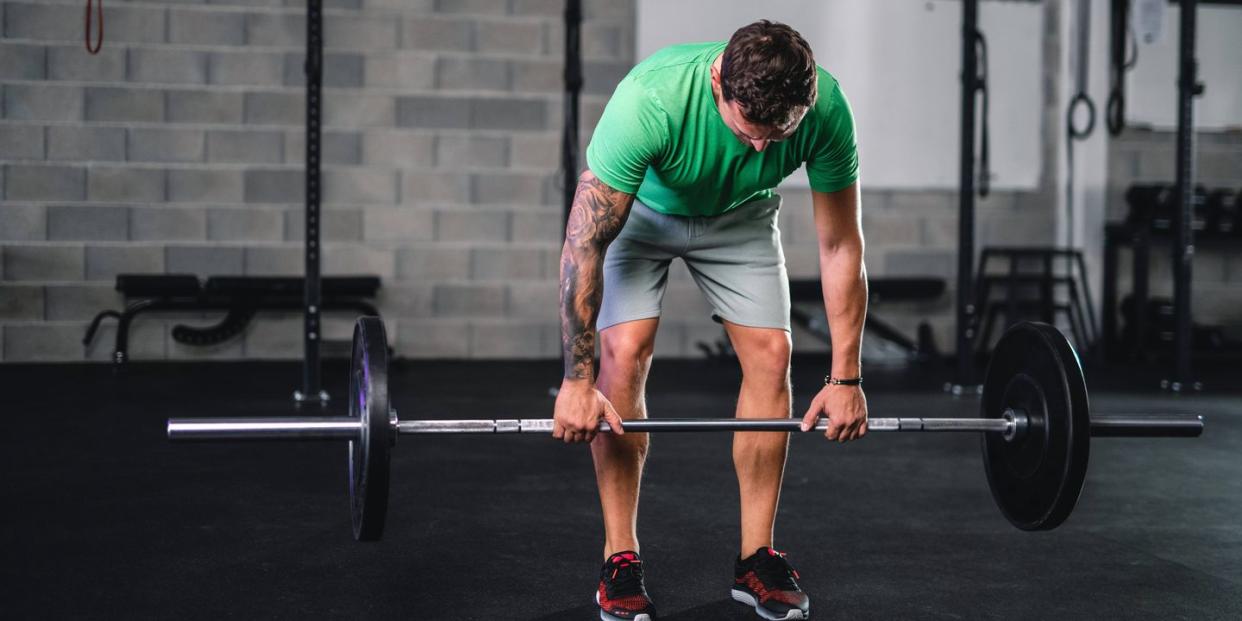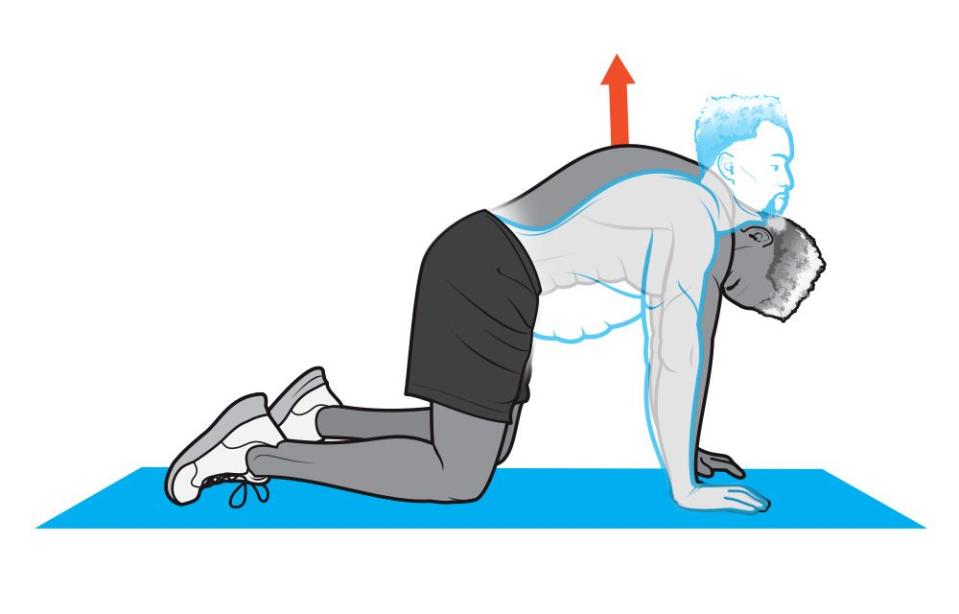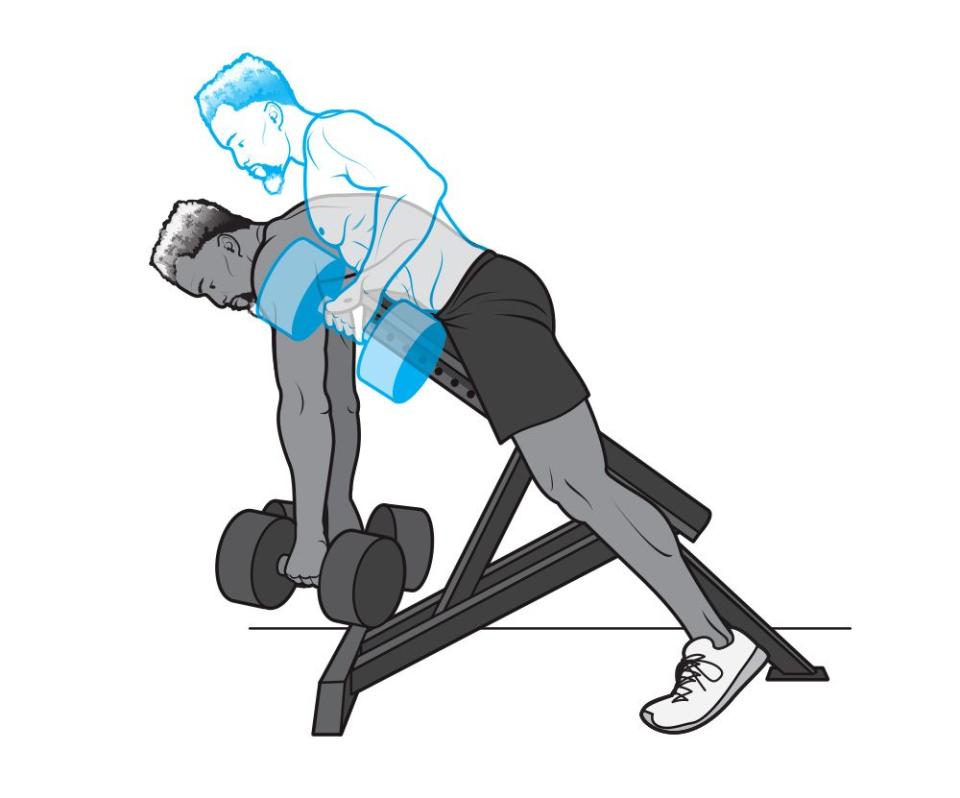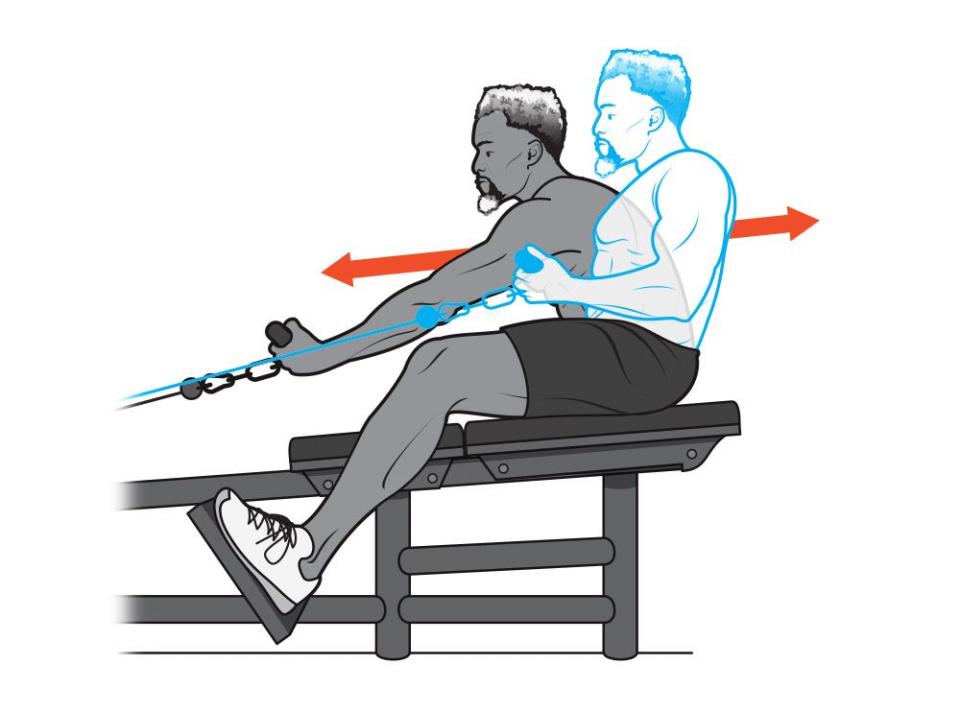Why You Should Reconsider Never Rounding Your Back to Lift

LIFT WITH YOUR legs, not with your back. You probably recall this phrase almost any time you bend down to lift something heavy. It makes sense, too, since conventional wisdom holds that rounding your back with heavy weight leads to injury. Except if you look closely at a strongman like Luke Stoltman hoisting a 300-pound atlas stone, you’ll notice that his spine isn’t ramrod straight at all. Instead, he’s almost hunching forward, curling his entire spine around the stone. And when you peruse fitness social media long enough, you may come across an exercise called the Jefferson curl, which asks you to stand holding a light barbell, then lower the barbell while simultaneously rounding your back as much as possible.
Truth is, rounding your back when you lift something can be completely natural, and learning how (and when) to do so just may unlock your body’s true strength. The technique has actually been used by powerlifters since the 1960s, says legendary strength coach Dan John, who can deadlift 22 pounds heavier when using roundback techniques. And it’s increasingly backed by science, too: One recent study found that participants had less compression and force on their spine when they rounded their backs to lift a 15kg box from the floor.
Tapping into all this power requires you to ignore the ongoing social media debates between roundback veterans and straight-spine zealots. Instead, focus on understanding the science of rounding your back by answering these five questions.
How Does Rounding Your Back Make You Stronger?
BY DARING TO round your back, you’re improving the range of motion of many exercises, especially the king of back-building moves, the row. And by taking you through a larger range of motion, you subject your muscles to more time-under-tension on every rep. You’re also training the spinal erectors of your upper back, a muscle group that’s oft-overlooked when you keep your spine rigid.
To feel this, try the roundback version of a chest-supported row. Traditionally, you’d lie with your chest on an incline bench, dumbbells held at your sides. Then you’d row the bells to your hips, squeezing your shoulder blades as you did. To do the roundback version, set up with your chest off the bench just slightly, dumbbells held at your sides. Now let your chest roll forward, reaching toward the ground with the bells. From this stretched position, row your elbows toward your hips. “It almost feels like you’re unlocking the ability to use certain upper back musculature better,” says strength coach Brandon Morgan. Do 3 sets of 8 to 10 reps.
But... Isn't Rounded Back Lifting Dangerous? How Do You Do It Safely?
NOT IF YOU do it correctly. The trick with rounding your back is understanding where that rounding is coming from, says Aaron Horschig, PT, DPT, CSCS. On most exercises, your goal is to stay rigid from the chest down (an area called your lumbar spine). Round only from the chest up (known as your thoracic spine). 'The thoracic spine is slightly different in its architecture,' says Horschig, 'in that the erector muscles that span the back and help offset shear load to protect the spine when rounded are different from the ones in the low back.'
The easiest way to assess this is the deadlift test. Set up for a deadlift, standing over a kettlebell or loaded barbell, butt pushed back. Start to pull the weight off the ground without lifting it. Have a friend take a photo of you from the side as you do this. If your back is rounded near your belly button, you’re in an unsafe position. If it’s rounded near your shoulders, you’re ready for action.
Which Exercises Is Rounded Back Lifting Best For?
ROW, ROW, ROW. Whether you’re doing a dumbbell row, a chest-supported row, or machine row, you can potentially integrate roundback training principles. But the easiest row variation to learn on is the classic seated cable row. Since you’re seated (and not standing), you won’t be in position to get injured even if you round the wrong section of your spine.
Start sitting on the bench of a cable row machine, hands on the cable handle, abs tight, torso nearly perpendicular to the ground. Row the load toward your belly button, pulling your elbows behind your torso as you do. Then slowly straighten your arms. Now comes the fun part: As you do this, spread your shoulder blades and reach the weight forward. 'Let the weight essentially drag your shoulders as far forward as possible,' says MH fitness director Ebenezer Samuel, C.S.C.S. 'You’ll feel an awesome stretch.'
So When Do I Keep My Spine in Neutral?
YOU'LL STILL WORK to keep your spine tight on most exercises, especially if you have a history of injuries, says Horschig: 'Every exercise is a tool, so when we are constructing an exercise program we want to pick out the right tools for the goals and the person.'
In general, it’s best to avoid rounding your back on your heaviest lifts. So if you’re taking on a one-rep max deadlift, work to keep your spine steady. Sure, you may be able to deadlift a smidge more if you round your back, but the added 10-pound plate on each side isn’t worth it. 'The risk to reward ratio just isn’t there,' says Morgan.
Avoid rounding your back on rows that start from the deadlift position, too. So if you’re doing a bent-over barbell row or gorilla row, aim to keep your spine in neutral, eliminating any possibility that the weight can pull your spine into poor position.
Can Any Stretches Improve My Rounded Back Strength Capabilities?
YOUR PATH TO roundback starts with a quintessential yoga stretch: the cat-cow. To do it, get on all fours, hands directly below shoulders, knees below hips. Then spread your shoulder blades and round your back up toward the ceiling. Slowly reverse the movement, then arch your back and squeeze your shoulder blades hard. Work back and forth between these two positions for 3 to 5 reps; do 4 sets.
You’re taking your spine through a great range of motion while doing this and also exposing your individual vertebrae to the movements they’re capable of. The best part: You can do this every day, continually building comfort with your back in a rounded position.
The end result: You’ll look and feel better—and be fully prepared for the next time your bestie wants to move a couch out of the apartment.
3 Moves for Rounded Back Training
ADD THESE EXERCISES into your routine to improve strength, mobility, and prep you for rounded back lifting.
Cat Cow

Get on all fours with your hands directly below your shoulders, knees below hips. Spread your shoulder blades and round your back up toward the ceiling. Slowly reverse the movement, then arch your back and squeeze your shoulder blades hard. Work back and forth between these two positions for 3 to 5 reps; do 4 sets.
Incline Reach Row

Set up with your chest off the bench just slightly, dumbbells held at your sides. Let your chest roll forward, reaching toward the ground with the bells. From this stretched position, row your elbows toward your hips. Do 8 to 10 reps; repeat for 3 sets.
Cable Reach Row

Start sitting on the bench of a cable row machine, hands on the cable handle, abs tight, torso nearly perpendicular to the ground. Row the load toward your belly button, pulling your elbows behind your torso as you do. Then slowly straighten your arms. As you do this, spread your shoulder blades and reach the weight forward, allowing it to pull you forward into a deep stretch. Do 8 to 10 reps; repeat for 3 sets.
You Might Also Like


